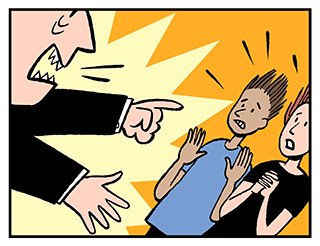Fear

“The streets of our country are in turmoil. The universities are filled with students rebelling and rioting. Communists are seeking to destroy our country. Enemies threaten us with their might, and the Republic is in danger. Yes – danger from within and without. We need law and order! Without it our nation cannot survive.”1
“Our convention occurs at a moment of crisis for our nation. The attacks on our police, and the terrorism in our cities, threaten our very way of life. Any politician who does not grasp this danger is not fit to lead.”2
When a propagandist warns members of her audience that disaster will result if they do not follow a particular course of action, she is using the fear appeal. By playing on the audience’s deep-seated fears, practitioners of this technique hope to redirect attention away from the merits of a particular proposal and toward steps that can be taken to reduce the fear.
This technique can be highly effective when wielded by a fascist demagogue, but it is typically used in less dramatic ways. Consider the following:
- A television commercial portrays a terrible automobile accident (the fear appeal), and reminds viewers to wear their seat-belts (the fear-reducing behavior).
- A pamphlet from an insurance company includes pictures of houses destroyed by floods (the fear appeal), and follows up with details about homeowners’ insurance (the fear-reducing behavior).
- A letter from a pro-gun organization begins by describing a lawless America in which only criminals own guns (the fear appeal), and concludes by asking readers to oppose a ban on background checks (the fear-reducing behavior).
- A letter from an anti-gun organization lists the names of more than 100 people who have died in school shootings (the fear appeal), and concludes by asking readers to boycott sporting goods stores that sell assault-style weapons (the fear-reducing behavior).
Since the end of the Second World War, social psychologists and communication scholars have been conducting empirical studies in order to learn more about the effectiveness of fear appeals. Some have criticized the conceptualization of the studies, and others have found fault with the experimental methods, but the general conclusions are worth considering, if not accepting.
- “All other things being equal, the more frightened a person is by a communication, the more likely her or she is to take positive preventive action.”3
- Fear appeals will not succeed in altering behavior if the audience feels powerless to change the situation.
- Fear appeals are more likely to succeed in changing behavior if they contain specific recommendations for reducing the threat that the audience believes are both effective and doable.
In summary, there are four elements to a successful fear appeal: 1) a threat, 2) a specific recommendation about how the audience should behave, 3) audience perception that the recommendation will be effective in addressing the threat, and 4) audience perception that they are capable of performing the recommended behavior.
When fear appeals do not include all four elements, they are likely to fail. Pratkanis and Aronson provide the example of the anti-nuclear movement, which successfully aroused public fear of nuclear war, but offered few specific recommendations that people perceived as effective or doable. By contrast, fall-out shelters were enormously popular during the 1950s because people believed that shelters would protect them from nuclear war, and installing a shelter was something that they could do.
In a similar fashion, during the 1964 campaign, Lyndon Johnson was said to have swayed many voters with a well-known television commercial (“Daisy”) that portrayed a young girl being annihilated in a nuclear blast. This spot linked nuclear war to Barry Goldwater (Johnson’s opponent), and proposed a vote for Johnson as an effective, doable way of avoiding the threat.
In contemporary politics, the fear-appeal continues to be widespread. When a politician agitates the public’s fear of immigration, guns, or some external threat, proposing that voting for her will reduce the threat, she is using this technique. When confronted with persuasive messages that capitalize on our fear, we should ask ourselves the following questions:
- Is the speaker exaggerating the fear or threat in order to obtain my support?
- How legitimate is the fear that the speaker is provoking?
- Will performing the recommended action actually reduce the supposed threat?
- When viewed dispassionately, what are the merits of the speaker’s proposal?
References
[1] For years, this quote was improperly attributed to Adolf Hitler. Although Hitler never actually spoke these words, they are an excellent illustration of a fear appeal.
[2] Associated Press (2016, July 21). Text of Donald Trump’s speech to the GOP convention. The State. [Note to readers: If you encounter any good examples of fear appeals from any side of the political spectrum, please let us know. You can reach us via the ‘Contact Us‘ link at the top of the page.]
[3] Anthony Pratkanis and Elliot Aronson (1991). Age of propaganda: The everyday use and abuse of persuasion. New York: W.H. Freeman. Page 210.
